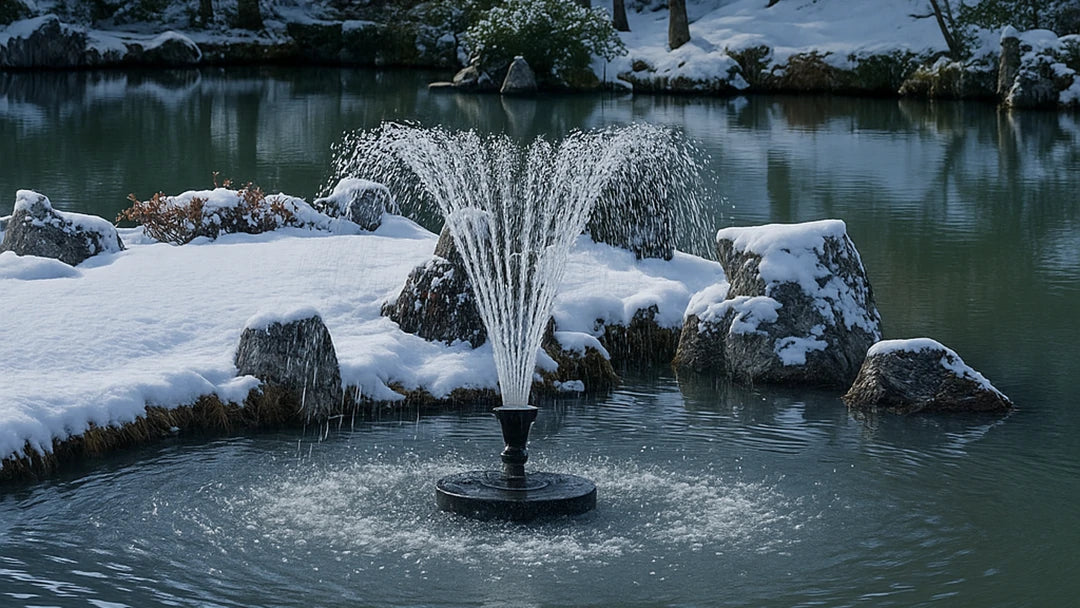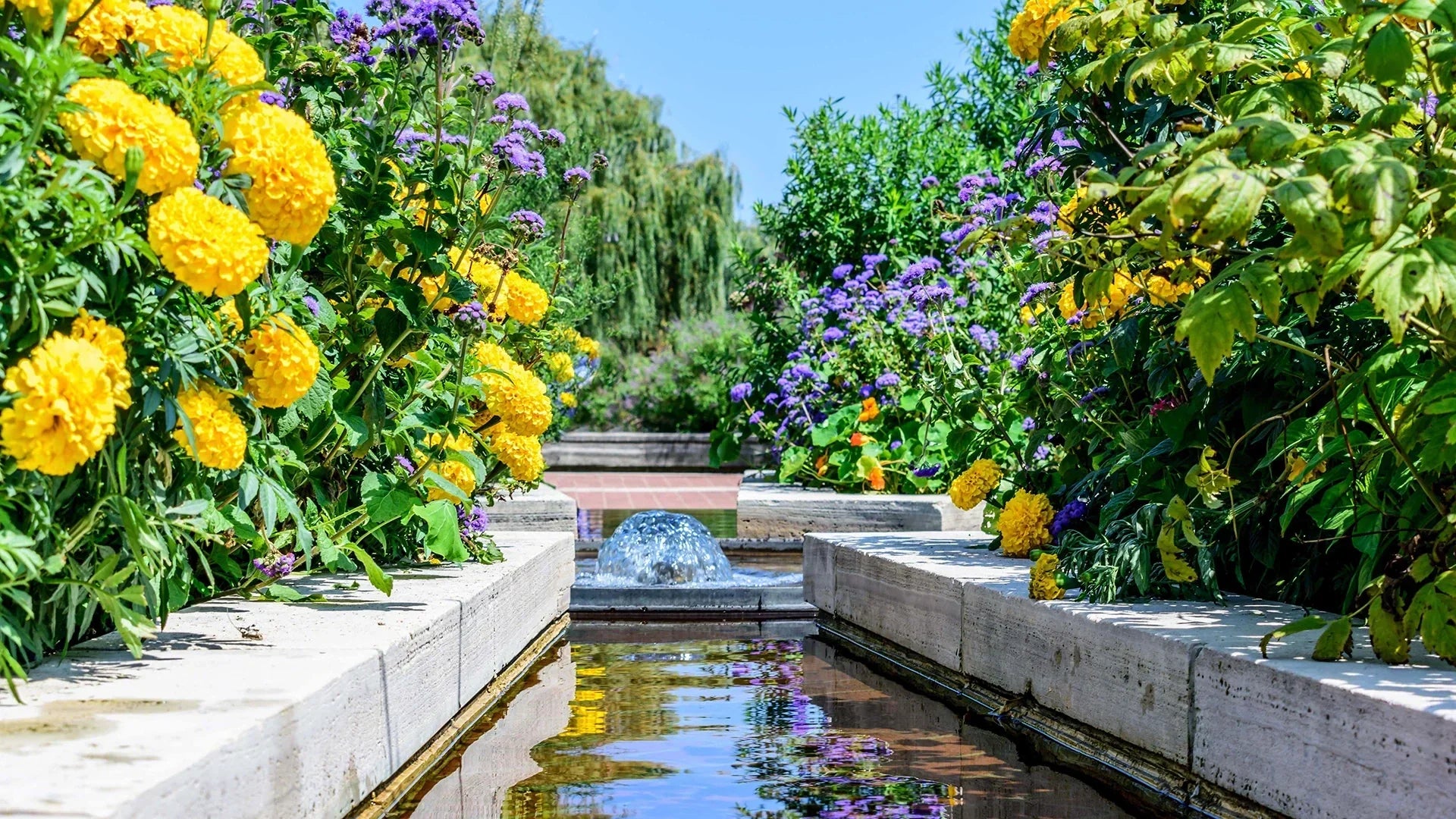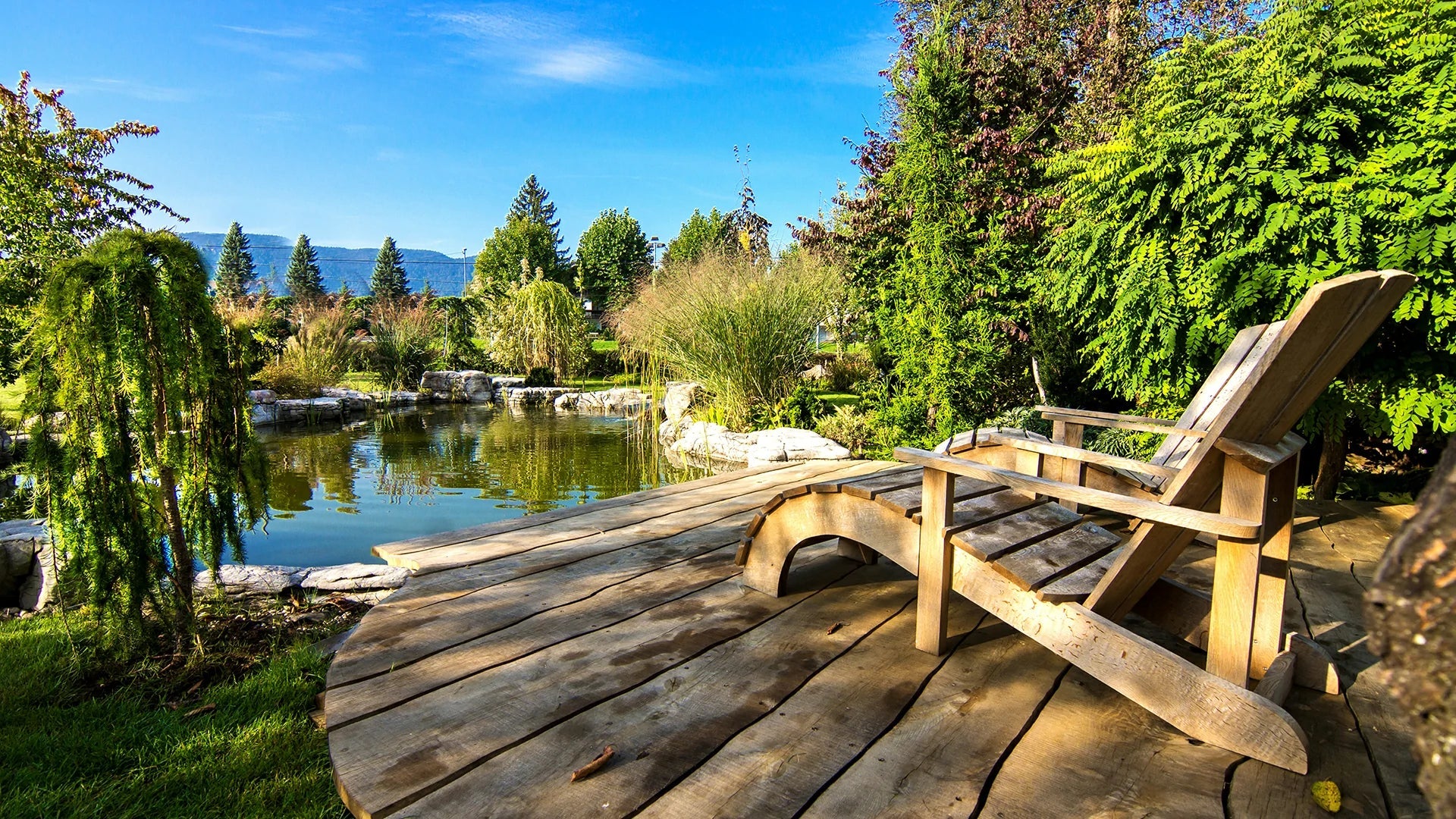Sobald der erste Frost kommt, kann ein ruhiger Gartenteich schnell unberechenbar werden. Fische ziehen sich zurück, Pumpen arbeiten auf Hochtouren und Laub gärt unter einer dünnen Eisschicht. Die gute Nachricht: Mit etwas Planung – und der richtigen netzunabhängigen Wasserzirkulation – ist die Teichpflege im Winter in gemäßigten Klimazonen unkompliziert. Nutzen Sie diese praktischen Tipps zur Teichüberwinterung, um Fische, Pflanzen und Technik zu schützen, damit Ihr Teich im Frühling klar und gesund erwacht.
Häufige Winterprobleme
- Nachts sinkt der Sauerstoffgehalt im Wasser. Kaltes Wasser enthält zwar mehr Sauerstoff, doch die Eisdecke verhindert den Gasaustausch. Nach dem Laubfall im Herbst oder dem Absterben von Algen kann der Sauerstoffgehalt gefährlich abfallen.
- Das Eis versiegelt die Oberfläche. Ein vollständig versiegelter Teich schließt CO₂ und andere Gase ein, was Kois und Goldfische stresst.
- Schnelle Temperaturschwankungen. Warme Tage und plötzliche Frostperioden können Fische schockieren und schlecht befestigte Kanten beschädigen.
- Ansammlung von Ablagerungen. Feuchte Blätter und Schlamm zersetzen sich zu Tanninen und Ammoniak, was das Wasser trübt und Winteralgen nährt.
- Stillstand der Zirkulation. Verstopfte Einlässe oder lange Leerlaufzeiten ermöglichen Schichtung und Kälteschock, wenn die tiefste Schicht gestört wird.
Frostschutzmaßnahmen
Man braucht keine Chemikalien, um das Fahrzeug „winterfest zu machen“ – man braucht Vorbeugung und eine sanfte, zuverlässige Bewegung.
- Halten Sie eine Entlüftungsöffnung frei. Lassen Sie eine handtellergroße Öffnung im Eis, damit Gase entweichen können; schlagen Sie niemals Eis (der Schock schadet den Fischen). An sonnigen Wintertagen reicht oft ein kleiner Wasserstrahl einer schwimmenden Solarfontäne aus.
- Leitungen anheben und isolieren. Schläuche vom blanken Boden abheben und die Leitungslängen verkürzen, um Wärmeverluste zu reduzieren. Oberwasserleitungen vor Wind schützen.
- Randstabilität. Vor dem ersten starken Frost lose Steine wieder festsetzen und Wasser nachfüllen, damit die Folien beim Zusammenziehen des Bodens nicht absacken.
- Laubkontrolle. Späte Blätter abschöpfen und saisonale Netze verwenden, bis der Laubfall endet; weniger organische Stoffe bedeuten weniger Sauerstoffverlust im Winter.
Pumpen- und Wasserzirkulationsmanagement

In den kalten Monaten ist das Ziel eine stetige, sanfte Zirkulation – kein tosender Wasserfall, der dem Teich die Wärme entzieht.
- Heben Sie die Tauchpumpen vom Meeresboden ab. Platzieren Sie sie 20–30 cm über dem Boden, damit die wärmste Schicht als thermischer Rückzugsort für Fische ungestört bleibt.
- Optimale Winterluftzufuhr. Die Luftmenge sollte nur alle 2–3 Stunden anstatt stündlich reguliert werden. So wird die Sauerstoffzufuhr aufrechterhalten, ohne dass es zu stark abkühlt.
- Teilen Sie die Aufgaben auf. Führen Sie einen Wasserkreislauf durch einen Solarteichfilter zum Polieren und einen zweiten durch einen Schwimmbrunnen zur Oberflächenbewegung. Wenn Sie einen kleinen Solarbelüfter hinzufügen, positionieren Sie den Ausströmerstein etwa in der Mitte des Teichs – nicht am tiefsten Punkt –, um ein Durchmischen der warmen Wasserschicht zu vermeiden.
- Planen Sie für Zeiten mit wenig Sonnenschein. Kurze Wintertage bedeuten schwankende Förderleistung. Ein kompakter Akku als Notstromversorgung in Kombination mit Ihrer Solarpumpe gleicht bewölkte Perioden aus und sorgt nach Sonnenuntergang für eine minimale Zirkulation.
- Wasserfallstrategie. Bei hohen und windigen Elementen sollte der Wasserdurchfluss gedrosselt oder der Überlauf vorübergehend umgangen werden, um die Verdunstungskühlung zu reduzieren. Ein flaches Wasserfall-Set oder eine Überlaufkante kann mit minimalem Wasserdurchfluss betrieben werden, um ausschließlich den Gasaustausch zu gewährleisten.
Tier- und Pflanzenschutz

Der Winter ist still, aber das Ökosystem atmet trotzdem.
- Fischpflege. Gesunde Koi und Goldfische überwintern gut, wenn der Teich tief genug ist (ca. 90–120 cm in kälteren Regionen) und der Sauerstoffgehalt stabil bleibt. Stellen Sie die Fütterung unter 10–12 °C ein, da unverdautes Futter das Wasser verschmutzt. Achten Sie auf Fische, die unter dem Eis nach Luft schnappen – vergrößern Sie in diesem Fall umgehend die Wasseroberfläche.
- Amphibien. Frösche und Molche überwintern in Schlammbänken oder Laubhaufen. Lassen Sie in Randzonen flache Uferbereiche und eine dünne Schicht sauberer Blätter stehen; vermeiden Sie es, jede Deckung auszubaggern.
- Pflanzen. Absterbendes Laub an Randpflanzen bis auf etwa 2,5 cm über dem Wurzelhals zurückschneiden, damit es nicht verfault. Winterharte Lilien in die tiefste Pflanznische setzen; empfindliche Schwimmlilien vor dem ersten Frost im Haus überwintern oder kompostieren.
- Raubtiermanagement. Eis kann Fische in sichtbaren Bereichen konzentrieren. Eine dezente Teichbeleuchtung (warmweißes Licht ist besser als blaues, da es weniger Insekten anlockt) und leichte Oberflächenbewegungen schrecken nachtaktive Jäger ab, ohne die Wildtiere zu verschrecken.
Poposoap Winteraccessoires

Das solarbetriebene Ökosystem von Poposoap macht die Wintervorbereitung sauberer und kabelloser:
- Solar-Teichfilter mit mehrstufigen Filtermedien halten Feinstoffe und organische Partikel in Schach, wenn Sie die Geräte nicht jedes Wochenende mit dem Gartenschlauch abspritzen können. Ihre kompakten Ansaugsiebe lassen sich leicht im Teichwasser ausschwenken.
- Schwimmende Fontänen erzeugen einen zuverlässigen Wasserstrahl für den Gasaustausch und die leichte Belüftung; viele verfügen über integrierte LEDs für eine sanfte Sichtbarkeit bei Nacht.
- Solare Belüfter fügen Blasen hinzu, ohne dass dafür ein Graben betrieben werden muss – ideal, um die notwendige Belüftungsöffnung und den Sauerstoffgehalt in mittleren Tiefen aufrechtzuerhalten.
- Wasserfall-Sets können im Winter mit reduziertem Durchfluss betrieben werden, um die Kühlung zu begrenzen und gleichzeitig die Zirkulation aufrechtzuerhalten.
- Notstromaggregate (unterschiedliche Kapazitäten) überbrücken bewölkte Nachmittage und verlängern die Belüftung bis in den frühen Abend – eine kleine Absicherung gegen Sauerstoffmangel.
Schnelle Winterroutine
(Tragen Sie es in Ihren Kalender ein)
- Spätherbst (vor dem ersten Frost): Laub mit Netzen entfernen, Pflanzen beschneiden, Pumpe höher stellen, Schlauchschellen prüfen und Filterschäume ausspülen.
- Bei Frost: Halten Sie eine Belüftungsöffnung mit einem Springbrunnen oder Belüfter offen; Eis niemals aufbrechen. Kontrollieren Sie den Wasserdurchfluss täglich.
- Auftauzeiten: Abgesetzten Schlamm absaugen, sofern der Zugang sicher ist; mit entchlortem Wasser, das annähernd die Teichtemperatur hat, auffüllen.
- Frühjahr: Nach dem letzten starken Frost wird die Wasserzirkulation allmählich wiederhergestellt und die Wasserfälle erreichen wieder ihre normale Geschwindigkeit.
Fazit
Eine erfolgreiche Teichpflege im Winter basiert auf Vorbeugung und einem sanften Gleichgewicht: weniger organische Stoffe, geschützte Wärmeschichten und eine gleichmäßige Sauerstoffversorgung. Wählen Sie eine der Jahreszeit angepasste Wasserzirkulation, sorgen Sie für dezente Beleuchtung und beachten Sie Tipps zur Teichüberwinterung, die Stress vermeiden. Mit den Solarfiltern, Belüftern, Schwimmbrunnen und Akkus von Poposoap bleibt Ihr Teich den ganzen Winter über stabil – für klares Wasser, ruhige Fische und ein entspanntes Frühjahr.





Hinterlasse einen Kommentar
Alle Kommentare werden vor der Veröffentlichung geprüft.
Diese Website ist durch hCaptcha geschützt und es gelten die allgemeinen Geschäftsbedingungen und Datenschutzbestimmungen von hCaptcha.